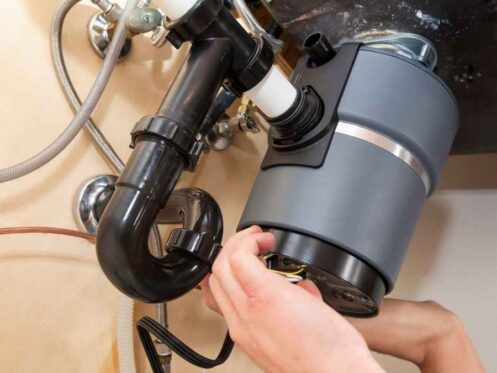Your garbage disposal is one of those kitchen appliances you don’t think about—until it suddenly stops working. Whether it hums but doesn’t spin, refuses to turn on, or makes a concerning grinding noise, a broken disposal can throw off your whole kitchen routine. While it may feel like a big problem, many garbage disposal issues have quick and simple fixes. From tripped breakers to clogged drains, there are several common reasons your disposal might stop functioning. Knowing what to look for—and how to safely troubleshoot—can save you time and stress.
In this blog, Dream Team Plumbing, Heating, Cooling & Electrical explains the most common garbage disposal problems, how to fix them, and when it’s time to call in the experts.
What’s Going On When Your Garbage Disposal Won’t Work?
When your garbage disposal suddenly stops working, it can be hard to know what went wrong. A properly functioning disposal should make a low, steady grinding noise as it breaks down food scraps and sends them through the drain. But when something’s off, the signs can range from silence to strange sounds—or worse, a backed-up sink.
In many cases, the disposal may simply hum without spinning, which often means the blades are jammed or the motor is struggling to turn. If it doesn’t make any sound at all, you could be dealing with a power issue, such as a tripped circuit or a unit that’s come unplugged. Other times, you might hear a loud rattle or buzz, or notice water draining slowly—or not at all.
These problems may seem small at first, but they can lead to bigger issues like clogs, odors, and damage to your plumbing system. Understanding what your disposal is (or isn’t) doing is the first step in figuring out how to fix it—and getting your kitchen back to normal.
Common Reasons a Garbage Disposal Stops Working
When your garbage disposal suddenly quits, the cause usually falls into one of three categories: power issues, mechanical problems, or drainage blockages. Understanding where the trouble lies will help you decide whether it’s a quick fix or a job for a professional.
Electrical and Power Issues
If your disposal won’t turn on at all—no sound, no hum—it might not be receiving power. This is often due to:
-
A tripped circuit breaker in your home’s electrical panel
-
An unplugged power cord (some disposals are plugged into an outlet under the sink)
-
The reset button on the bottom of the unit may have popped out (look for a small red or black button to push back in)
Mechanical Problems
Sometimes the disposal has power but still won’t work properly. You may hear it hum or buzz without the blades spinning. Common mechanical issues include:
-
Jammed impeller blades, often caused by food scraps like bones or fibrous vegetables
-
A stuck or worn-out flywheel that prevents proper rotation
-
Internal motor failure, which typically requires replacement
Drain or Clog-Related Issues
A garbage disposal is connected directly to your kitchen sink drain, so anything affecting drainage can impact its function:
-
Disposal clogs often result from items like grease, eggshells, or pasta being put down the drain
-
P-trap clogs (the curved pipe beneath the sink) can block water and ground-up food from flowing out
-
Backups or slow drainage might indicate a deeper clog beyond the disposal
Each of these issues presents a different set of solutions, some of which you can try yourself—others that are best left to a licensed technician.
How to Fix a Garbage Disposal That Stopped Working
Before you assume the worst, there are several safe and simple things you can try to get your garbage disposal running again. Many common problems—especially those related to jams or power—can be fixed in just a few minutes. However, knowing when to stop and call a professional is just as important.
DIY Fixes to Try First
-
Press the Reset Button: Locate the small red button on the bottom of the disposal unit. If it’s popped out, press it back in, then try turning the disposal on again.
-
Check the Power: Make sure the unit is plugged in and that the kitchen circuit breaker hasn’t tripped.
-
Free a Jam with an Allen Wrench: Most disposals come with a small hex key (usually ¼ inch). Insert it into the hole at the bottom center of the unit and twist it back and forth to manually loosen the jammed flywheel.
-
Inspect and Clear the Drain: Remove the drain cover and use tongs or pliers to gently remove any visible debris—never use your hand inside the unit.
-
Avoid Drain Cleaners: Chemical cleaners can damage the disposal and are not effective against mechanical blockages or jams.
If the unit powers on and runs smoothly after these steps, you’re in the clear. If not, it may be time for a deeper diagnosis.
When to Call Dream Team Plumbing, Heating, Cooling & Electrical
Some problems are better left to professionals—especially if:
-
The motor hums but the blades don’t spin, even after trying to manually rotate the flywheel
-
There’s a burning smell, buzzing, or smoke, indicating a failing motor
-
Water is leaking from the disposal or plumbing connections
-
The unit won’t turn on even after resetting and checking power sources
-
You’re facing repeated clogs or drainage issues, even with careful use
At Dream Team Plumbing, Heating, Cooling & Electrical, we’ll diagnose the issue quickly and safely—whether you need a repair, a replacement, or a deeper plumbing inspection.
How to Prevent Garbage Disposal Problems in the Future
A little care goes a long way when it comes to keeping your garbage disposal in top shape. With proper use and occasional maintenance, you can avoid most of the common problems that lead to jams, clogs, or system failures.
Best Practices for Daily Use
-
Run Cold Water Before and After Use: Let cold water run for at least 15 seconds before turning the disposal on, and keep it running while the unit is grinding. Cold water helps solidify grease and fat so it can be chopped up and flushed through the system more effectively.
-
Grind in Moderation: Don’t overload the disposal with large volumes of food at once. Feed scraps gradually to avoid jamming the blades or overworking the motor.
-
Know What to Avoid: Never put the following down your disposal:
-
Grease or oil
-
Coffee grounds
-
Eggshells
-
Bones
-
Fibrous vegetables (like celery or corn husks)
-
Pasta or rice (they expand and gum up the system)
Routine Cleaning and Maintenance
-
Clean Monthly: Use a mix of baking soda and vinegar to freshen the unit and remove buildup. Let it fizz for a few minutes, then rinse with cold water.
-
Add Citrus Peels Occasionally: Grinding lemon or orange peels helps eliminate odors and clean the blades naturally.
-
Schedule Routine Plumbing Inspections: During a general plumbing tune-up, your technician can check the disposal for leaks, wear, and efficiency.
Taking these steps not only prevents breakdowns—it also helps extend the life of your garbage disposal.
Wrap-Up: Get Your Garbage Disposal Running Again—Fast
A broken garbage disposal can bring your kitchen to a standstill—but in many cases, the fix is easier than you think. From pressing the reset button to freeing up a jammed flywheel, a few basic troubleshooting steps might be all you need to get things grinding again. But if your disposal still won’t work, keeps clogging, or shows signs of electrical or motor failure, it’s time to bring in the pros.
At Dream Team Plumbing, Heating, Cooling & Electrical, we’re ready to help with fast, reliable garbage disposal repair and installation. Don’t let a minor kitchen issue turn into a major hassle—contact our team today and we’ll get your sink back in working order in no time.



